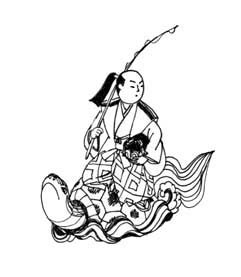|
||
 |
||
@

(C)2001 Japanese Architecture and Art Net Users System.@No reproduction or republication without written permission.
fΪΜeLXgEΚ^ECXgΘΗASΔΜRecΜ³f‘»E]ΪπΦΆά·B
|
||||||
| @ | ||||||
| Urashima@Y | ||||||
| KEY WORD :@art history / paintings | ||||||
| @ | ||||||
| The hero and title of an ancient tale of a fisherman and his magical journey to a palace beneath the sea. The details vary, but the basic narrative tells how a fisherman Urashima Tarou YΎY (alternately Urashima no ko YΜq or Shima no ko Μq) meets a beautiful young woman who takes him to her father's fabulous undersea palace. In some versions the woman's original form is that of a sea turtle either caught by the fisherman or rescued by him from malicious children. The woman often was associated with Otohime ³P, daughter of the Dragon King, and the undersea Dragon Palace, Ryuuguu ΄{. In any case, Urashima marries the woman and they live together for three happy years until he decides to make a brief trip home. His wife grants him his wish, giving him a magic box that will allow his return but with the warning that it should never be opened. Urashima reaches his former home only to find everything changed and himself a stranger there. Confused, he opens the box. From it rise wisps of white smoke and instantly the young Urashima becomes a wizened old man and dies. In fact, he had been absent for 300 years. The oldest extant version is found in the TANGO FUDOKI OγyL (Local Records of Tango, 713), with alternative versions in the SHOKUNIHONGI ±ϊ{I (797). Extant examples of the story, entitled The Legends of the God Urashima Urashima myoujin engi YΎ_N, depicted both on a handscroll *emaki Gͺ in the early 14c, and a hanging scroll *kakemono |¨ in the early 16c, were kept in Ura Jinja FΗ_Π, Kyoto, where the event took place, according to the YUURYAKUKI YͺL. The illustration of Urashima became popular in the Edo period, typically with a young fisherman seated on a tortoise and holding a fishing rod, or with an old man holding a small box. *Ukiyo-e ’G artists associated the theme with views of Kanagawa (where the events took place according to some later accounts) or with *mitate-e ©§G versions that feature a beautiful woman in place of the fisherman. | ||||||
| @ | ||||||
| @ | ||||||
@  |
||||||
| REFERENCES: | ||||||
| @ | ||||||
| EXTERNAL LINKS: | ||||||
| @@ | ||||||
| NOTES: | ||||||
| @ | ||||||
(C)2001 Japanese Architecture and Art Net Users System.@No reproduction or republication without written permission. fΪΜeLXgEΚ^ECXgΘΗASΔΜRecΜ³f‘»E]ΪπΦΆά·B |
||||||
| @ |